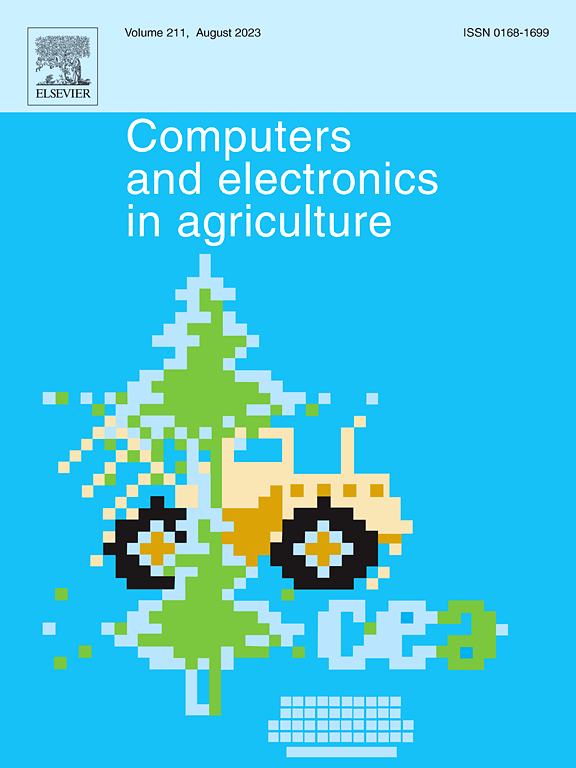数据驱动的繁殖性能建模:提高母猪效率和畜牧业可持续性的队列研究
IF 8.9
1区 农林科学
Q1 AGRICULTURE, MULTIDISCIPLINARY
引用次数: 0
摘要
由于缺乏高质量的数据、有限的大规模模型和低硬件覆盖率,物联网(IoT)在养猪生产中的发展缓慢,阻碍了精准饲养实践的广泛采用。本研究旨在通过提供标准化数据集作为物联网开发的基础,并构建以出生窝重(BLW)和断奶窝重(WLW)为重点的预测模型,来解决这些挑战。为了实现这些目标,收集了两个综合数据集,包括10,089头母猪的特征。通过对8种不同算法的比较,选择GBDT算法作为BLW和WLW建模的最优算法。数据集被分成90%的样本用于模型推导,剩下的10%用于模型验证。BLW和WLW数据集的模型在主队列和验证队列之间表现出一致的性能,误差幅度小,相对精度高(MAE: 1.8-2.5, MAPE: 2.55% - 18.41%, R >;60%),表明鲁棒性和对未知数据的可泛化性。更进一步,SHAP总结图表明,在BLW模型中,G.ADFIp2、G.ADFIp3、G.ADFIp4、G.ADF和奇偶性对预测有显著影响。在WLW模型中,主要影响因素为断奶窝数、泌乳期、胎次和初生窝重。SHAP力和依赖图揭示了各种特征对模型结果的复杂影响。为了增强可访问性,我们使用Streamlit Python框架开发了一个用户友好的可视化和预测网站。这些重要的研究结果为决策者提供了宝贵的见解,促进了养猪业精准饲养模型和物联网技术的进步。最终,这有助于实现提高畜牧业综合可持续性的总体目标。本文章由计算机程序翻译,如有差异,请以英文原文为准。

Data-driven modeling of reproductive performance: a cohort study for elevated sow efficiency and sustainability in livestock farming
The slow development of the Internet of Things (IoT) in pig production, due to the lack of high-quality data, limited large-scale models, and low hardware coverage, has hindered the widespread adoption of precision feeding practices. This study aimed to address these challenges by providing a standardized dataset as a foundation for IoT development and constructing predictive models focused on birth litter weight (BLW) and weaned litter weight (WLW). To achieve these objectives, two comprehensive datasets consisting of 10,089 sow characteristics were collected. By comparing eight different algorithms, GBDT algorithm was selected as the optimal algorithm for modeling of BLW and WLW. The datasets were divided into a 90 % sample for model derivation, with the remaining 10 % used for model validation. The models for both BLW and WLW datasets exhibited consistent performance between main and validation cohorts, with low error magnitudes and high relative accuracy (MAE: 1.8–2.5, MAPE: 2.55 %–18.41 %, R > 60 %), indicating robustness and generalizability to unseen data. Delving deeper, the SHAP summary plots illustrated that in the model for BLW, G.ADFIp2, G.ADFIp3, G.ADFIp4, G.ADF and parity had a significant impact on the prediction. In the WLW model, the key influencing factors were weaned litter size, duration of lactation, parity, and birth litter weight. SHAP force and dependence plots had uncovered intricate effects of various features on the model’s outcomes. To enhance accessibility, we developed a user-friendly visualization and prediction website using the Streamlit Python framework. These critical research findings provide decision-makers with invaluable insights, fostering advancements in precision feeding models and IoT technologies in the swine industry. Ultimately, this contributes to the overarching goal of enhancing the comprehensive sustainability of livestock farming.
求助全文
通过发布文献求助,成功后即可免费获取论文全文。
去求助
来源期刊

Computers and Electronics in Agriculture
工程技术-计算机:跨学科应用
CiteScore
15.30
自引率
14.50%
发文量
800
审稿时长
62 days
期刊介绍:
Computers and Electronics in Agriculture provides international coverage of advancements in computer hardware, software, electronic instrumentation, and control systems applied to agricultural challenges. Encompassing agronomy, horticulture, forestry, aquaculture, and animal farming, the journal publishes original papers, reviews, and applications notes. It explores the use of computers and electronics in plant or animal agricultural production, covering topics like agricultural soils, water, pests, controlled environments, and waste. The scope extends to on-farm post-harvest operations and relevant technologies, including artificial intelligence, sensors, machine vision, robotics, networking, and simulation modeling. Its companion journal, Smart Agricultural Technology, continues the focus on smart applications in production agriculture.
 求助内容:
求助内容: 应助结果提醒方式:
应助结果提醒方式:


